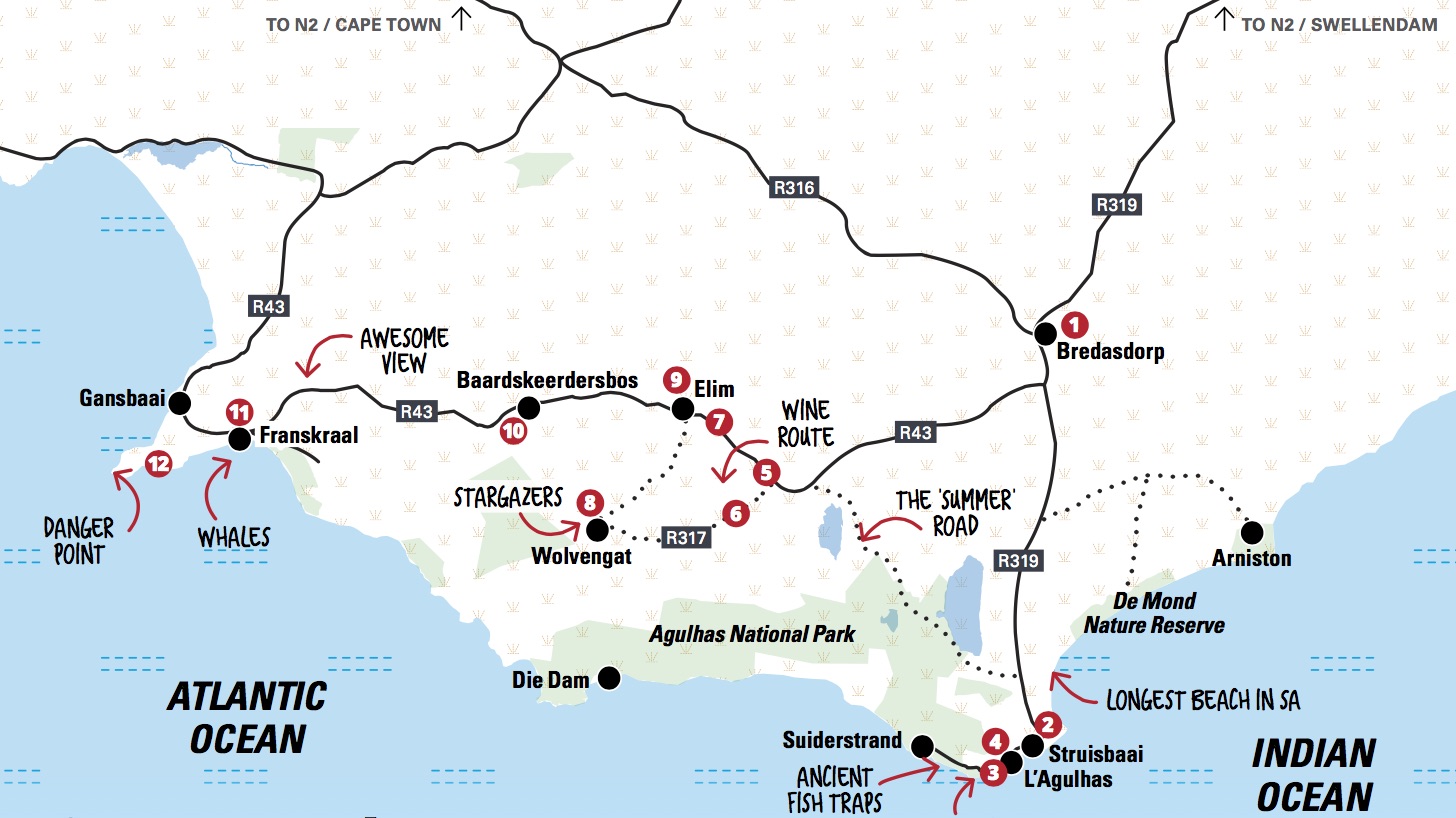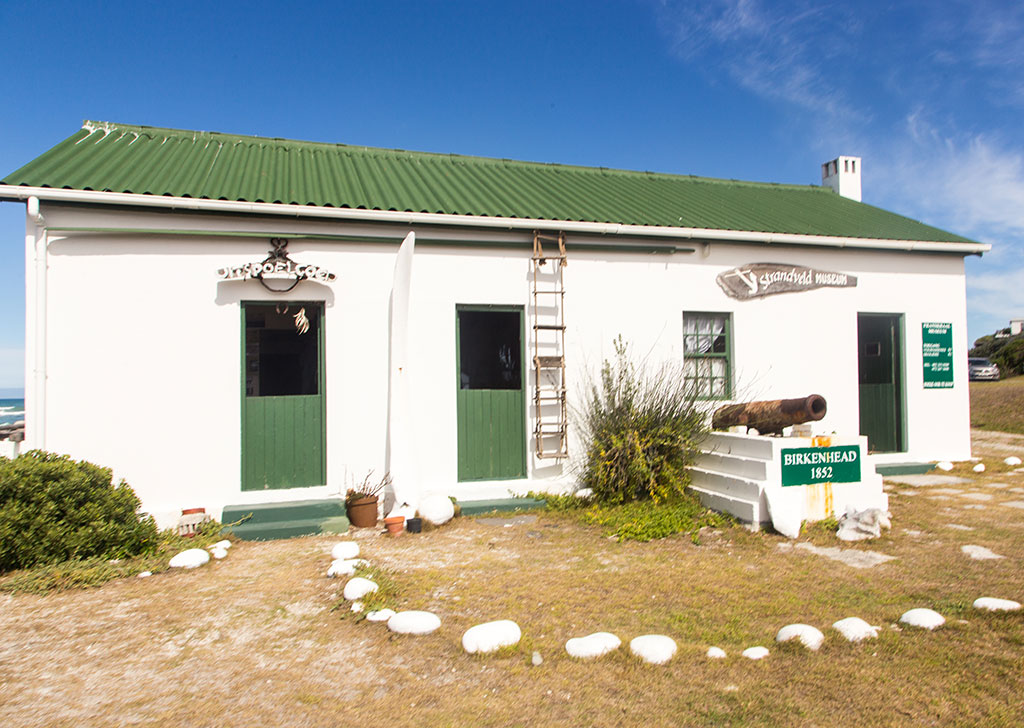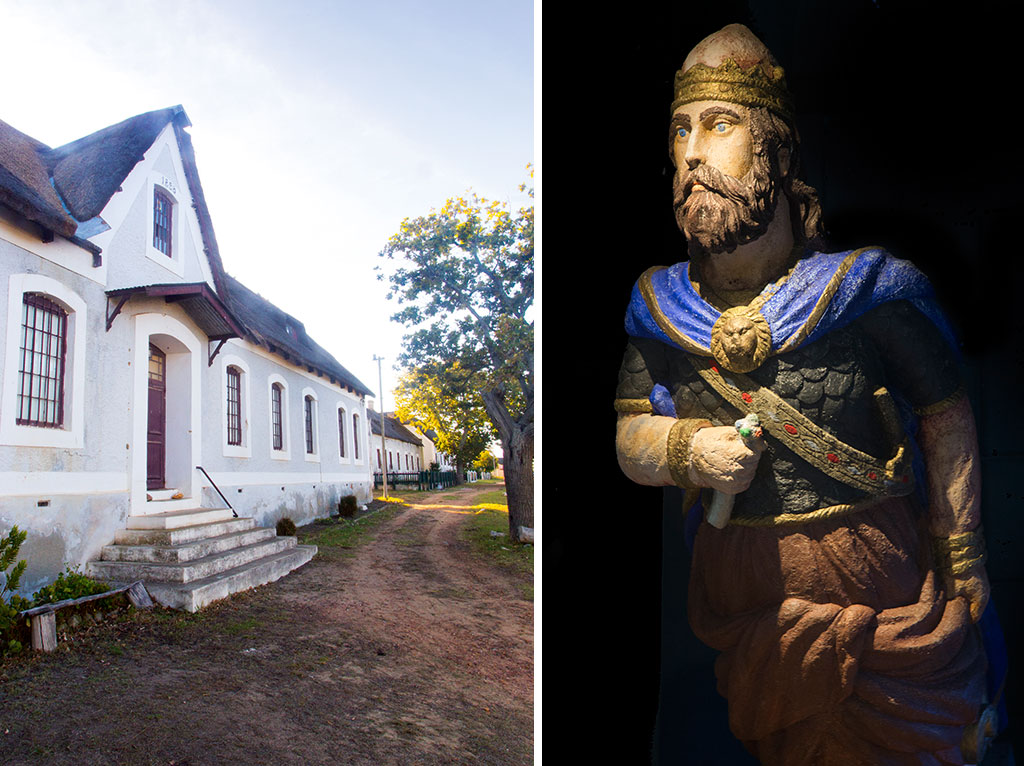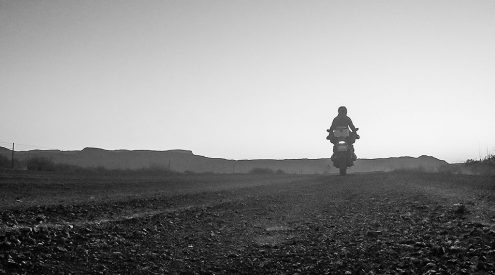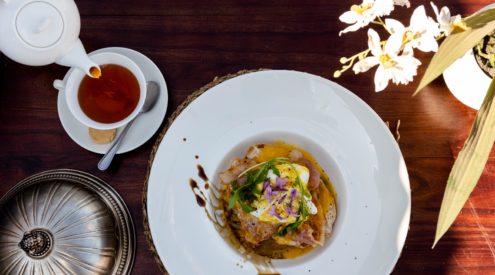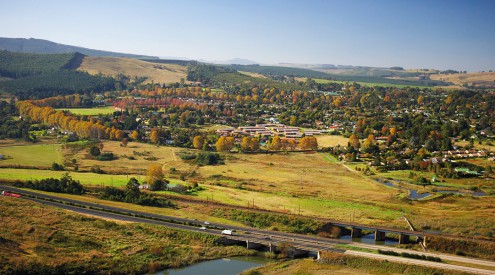It’s whale season in the Southern Cape. If you’re there to see the whales, explore beyond Hermanus and take in the breathtaking coastline they swim past and the inland places lost in time.
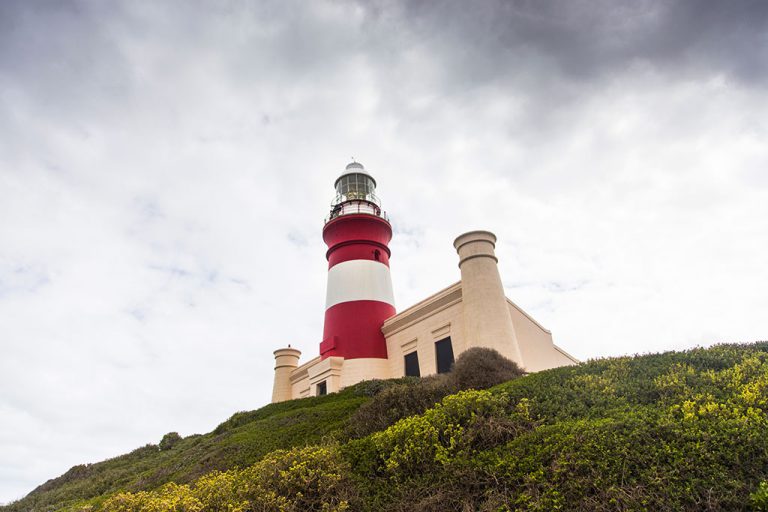
The top of the lighthouse is a great vantage point for spotting whales passing Cape Agulhas en route to Walker Bay. Photo by Caroline Webb
Once upon a time, the southern tip of Africa was a big deal – the gateway to the East by sea. It turned out to be a tempestuous place. The waters around Agulhas, that southern tip, have officially claimed 129 ships since 1673; the most recent was in 1982. It makes sense, then, that a journey to the deep south should include a visit to the Shipwreck Museum. That’s where I chose to start this road trip, in Bredasdorp, also the ‘capital’ of the Agulhas region.
I had originally intended to start in Gansbaai and drive down the long stretch of coast until the tar road ended, at Die Dam, and then cut across the Agulhas Plain to the southern tip. But people I spoke to said it was ‘boring, with nothing to see except alien trees’ and no sea views to speak of. Bredasdorp is easily reached from the N2, giving access to anyone coming from Cape Town side or the Garden Route, or inland from the Robertson valley.
Bredasdorp’s Shipwreck Museum was wonderfully atmospheric, with a soundtrack of waves and seagulls that made me eager to get to the coast. The road leads straight down the Agulhas Plain, through fynbos that twists and clumps and forms patterns and textures. On the horizon, in an otherwise clear blue sky, a bank of clouds hovered over where the coast was.
It wasn’t until I entered Struisbaai that I caught a glimpse of the sea: stunningly tropical-looking water in glorious blue-green hues. I needed to see more, and took a left to the harbour, where an impossibly quaint scene unfolded: a dozen multi-coloured little fishing boats (called ‘chokkas’) at anchor in the calm bay, flocks of seagulls and a golden beach stretching off to the left.
People came and went – turns out, Struisbaai harbour is the centre of town, and everyone makes a turn here to see what’s happening (and whether Parrie the famous stingray is there).
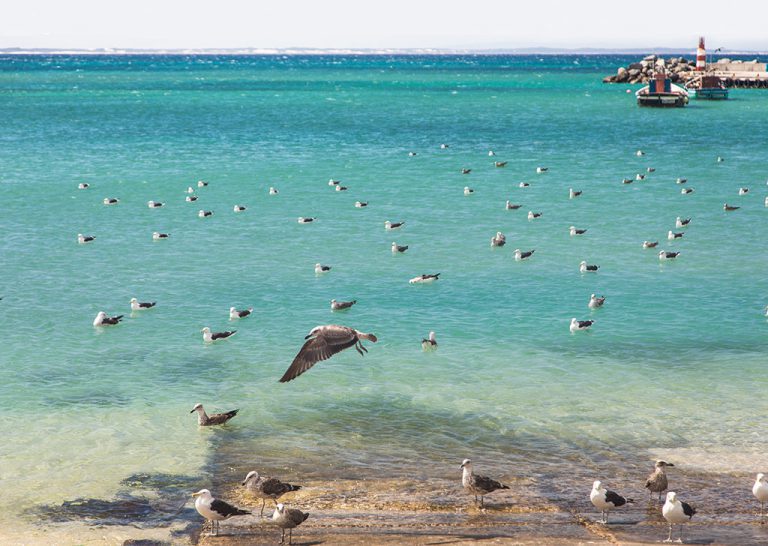
The Struisbaai Harbour. Photo by Caroline Webb
I walked along the boardwalk behind the beach, past a group doing a sea-yoga class, to a second, much longer stretch of sand that continues for 14 kilometres to Arniston. Back in the car, Marine Drive curls around the corner (evocatively called Spookdraai) alongside a rugged coast dotted with lonely benches. This stretch between Struisbaai and L’Agulhas, due to ever-increasing development, is now practically one town.
By mid-afternoon, the weather had turned – the four seasons in a day that locals speak of. It was overcast and the wind had picked up … appropriate for a visit to the southern tip of Africa. To be honest, it didn’t feel like the end of Africa; it didn’t even feel like I was standing on a ‘tip’, but it does have a sense of ‘occasion’. The woman at the info centre in the lighthouse had said that if I walked 10 metres to the right of the monument, I’d be standing exactly in line with the meeting place of the two oceans. So I did that, but there was no obvious sign – no mixing of two different shades of blue.
There are plans for developing this site, with a much more monumental, abstract structure involving paving in the shape of Africa. It will surely make the experience feel ‘grander’, but I’d urge people to get here while it’s still a relatively simple place.
Before leaving L’Agulhas the next day, I stopped in at the ‘shell house’ up on the hill. Owner Mosie Hope is an anti-plastic and recycling advocate, who turns all the junk she finds on her shore walks into artworks. She’ll happily show visitors around her ‘museum’, containing many amazing things – I had no idea, for example, that shells start out as eggs (which look a little like caviar).
Just outside Struisbaai there’s a turn-off to Elim, a shortcut across the Agulhas Plain taking you past wetlands – including Voëlvlei and Zoetendalsvlei, the second largest wetland system in South Africa. However, it’s gravel and the locals call it the ‘summer road’ for good reason; in winter it all turns into marsh.
There is another turn-off to Elim further up, on a new tarred road linking Gansbaai to Bredasdorp. It has increased the traffic through this little-visited part of the Overberg, and opened up access to a new wine route. Black Oystercatcher is the estate most people mention; Strandveld is five kilometres down the gravel road to Die Dam, and Zoetendal is the last estate just before Elim. These farms are not grand and historic, like many in the Winelands, but they’re a welcome anomaly out here and the cool-climate, eco-friendly wine is good.
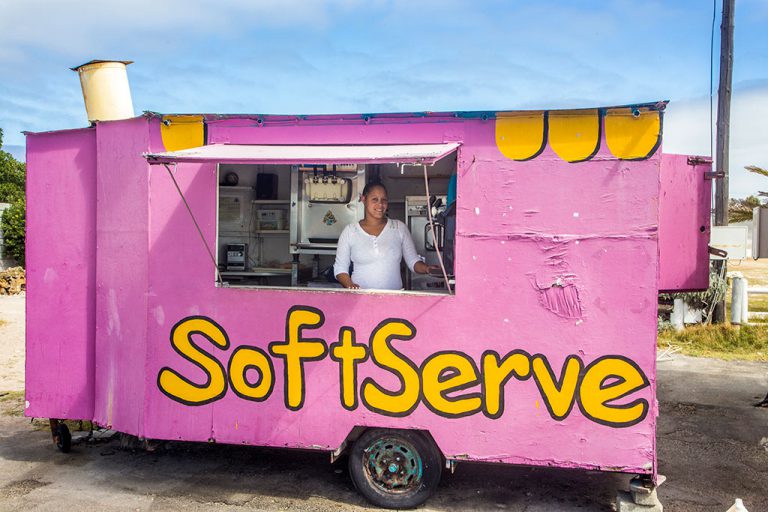
A classic seaside treat at Struisbaai. Photo by Caroline Webb
I’d been told in L’Agulhas that the road between Elim and Wolvengat is one of the most beautiful drives in spring when the fynbos blooms; even though it’s the wrong season, I decide to try it out, because who can resist a place called Wolvengat? No other car passed me, there were some beautiful views, and I had a real feel of rewinding time, stumbling on this sleepy hamlet lost to the world. ‘More people used to come this way, when gravel roads were the only way to get around this area, but since the R43 was tarred the traffic here has virtually stopped,’ artist Tina de Roubaix tells me. I’m not sure if she’s glad or sad.
Back in Elim I bought a soft-serve ice cream at the Royal Cafe and took a stroll. A mission station founded in 1824, built around an enormous church, it has an old working waterwheel and colourful cottages lining the main street. Sitting under the palm trees in the church garden, I became aware that the church bell tolls every 15 minutes. The passing of time marked gently is something beautiful and sadly forgotten.
The following morning I headed back to the coast, passing Baardskeerdersbos, a once-forgotten hamlet becoming more famous thanks to an influx of artist– its fortunes the opposite of Wolvengat’s. This road from ‘B-Bos’ was probably the most scenic of the trip, with welcome mountainscapes, and again I could see a bank of clouds hovering on the horizon. Cresting a rise about halfway to Gansbaai, I saw the sea again and pulled over at a perfectly placed padkos spot right there, with a glorious vista: a great swathe of southern ocean to behold.
It’s fitting that my journey would end at Danger Point – another notorious shipwreck spot, most famously where the Birkenhead came to grief. Before I got there, though, I stopped in Franskraal, with its lovely beach and promenade (lesser-known prime whale-watching territory) and, drawn to a whitewashed cottage in the distance, discovered the eccentric Strandveld Museum.
Then I kept following the coast, passing Kleinbaai (the harbour from which the shark-diving boats leave, before heading out to the lighthouse. I left for home feeling a little haunted, yet with a head full of magnificent seascapes.
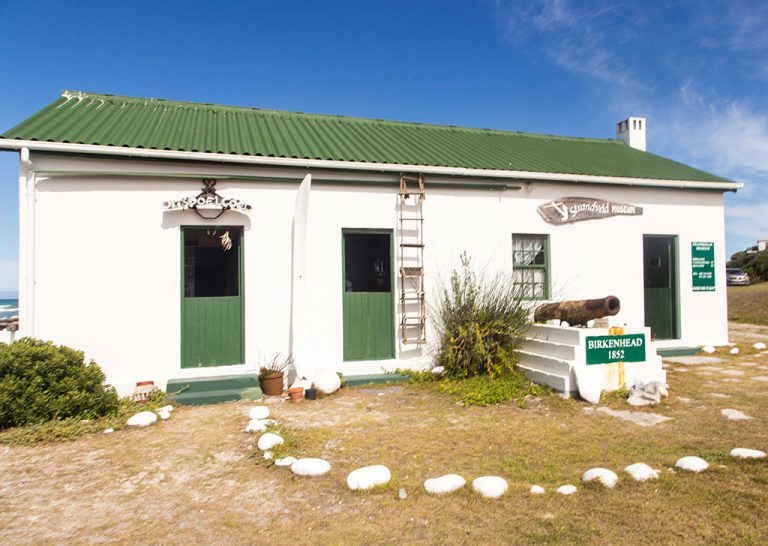
At Franskraal. Photo by Caroline Webb
Do this great whale-watching route
Day 1: Bredasdorp to L’Agulhas
Distance 52km Time 8 hours
Head to Bredasdorp, off the N2 on the R316 from Caledon (or R319 from Swellendam). Visit the Shipwreck Museum (1) then leave town on the main street, which becomes the R319. After 30km you will arrive in Struisbaai. Turn left at the sign to the harbour (R5 entry). After some beachcombing and lunch (2), continue on the main road, which becomes Marine Drive, to L’Agulhas and the lighthouse (3). Drive to the southernmost tip, then continue on the dirt road past the shipwreck. Look for the SANParks sign (about 2km after the wreck) to locate the boardwalk to Rasperpunt (ancient fish traps visible at low tide). A little further on is the left turn into Suiderstrand – follow the tar road to the beach. Drive back to L’Agulhas if sleeping there (4), or the gate of Agulhas National Park is just beyond Suiderstrand.
Day 2: L’Agulhas to Elim
Distance 90km Time 8 hours
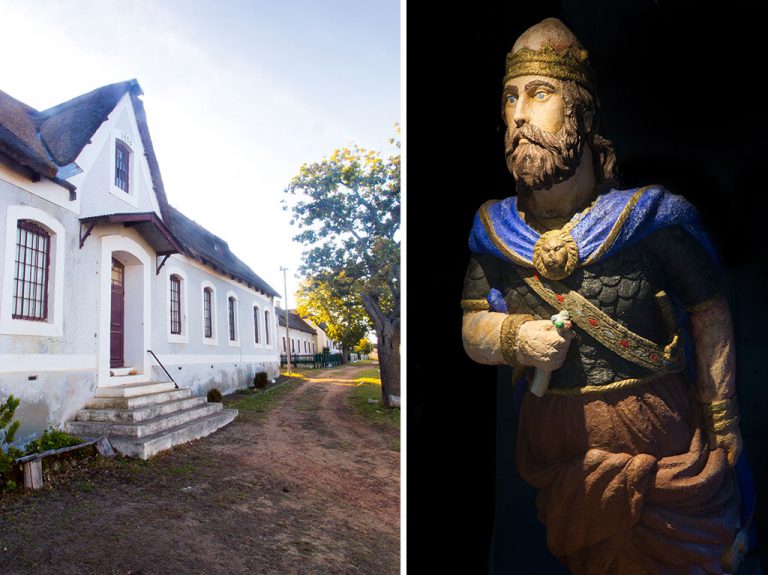
A row of mid-19th century buildings in Elim (one of them is the only guesthouse in town); The Shipwreck Museum. Photo by Caroline Webb.
Visit the tidal pools early, have breakfast and pop in at the ‘shell house’ (8 Golf Street, tel 0822960144) before leaving town. Retrace your route through Struisbaai and back on the R319. After 27km, turn left to Elim. After 23km you will see Black Oystercatcher (5) wine estate; turn left down the dirt R317 to get to Strandveld Vineyards (6), a 5km drive, or continue 6km further on the R43 to Zoetendal (7). Drive into Elim, turn left at the stop street and take a 12km country drive on gravel to Wolvengat (8). Return to Elim (9) on the same road (or continue through the hamlet to reach the R317 after 8km, and turn left to get back on the R43). Check in at Elim Guesthouse and be sure to arrange dinner.
Day 3: Elim to Gansbaai
Distance 65km Time 7 hours
Take a stroll around town before leaving on the R43 to Gansbaai. After 18km you will reach Baardskeerdersbos (10). Continue to Gansbaai; look out for the viewpoint after 12km. Further down in the valley, at the T-junction, turn right then left to Franskraal and head to the shore. Stretch your legs on the promenade and visit the Strandveld Museum (11). Continue north, hugging the coast; at Kleinbaai you’ll have to head away from the sea. At the T-junction into Van Wyk Drive, take a right to the penguin sanctuary (12) and a left to Danger Point lighthouse (10:00 – 15:00, closed on weekends). From here it’s 10km to Gansbaai, and on from here to prime whale-watching destinations, De Kelders and Hermanus.
If you have more time
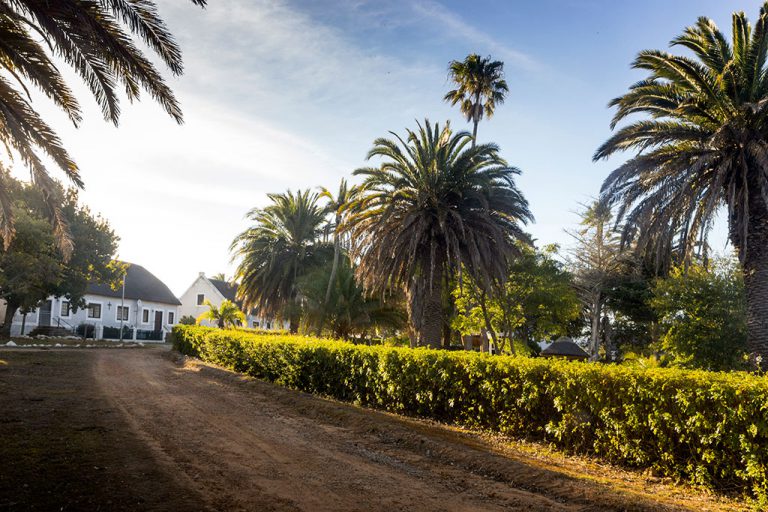
Elim in lovely afternoon light. Photo by Caroline Webb
Spend an extra day at Cape Agulhas – there are several great walks, including the Sterna Trail (four hours) in De Mond Nature Reserve; take the Arniston turn-off 16km out of Struisbaai. There is also Sea Shack, a beach BBQ spot in Struisbaai – call ahead to find out if they’re doing their seafood buffet feast (tel 0724554460). It’ll take all afternoon. For more info on visiting the Agulhas Plain wetlands (there are bird hides and buffalo herds, and hiking trails are planned), see nuwejaars.com.
Where to see whales
There are five coastal trails in the Cape Agulhas area, including boardwalks, as well as long beaches at De Plaat (Struisbaai) and Suiderstrand – if you keep your eyes on the sea, you’ll spot whales swimming past. They’re all headed for Walker Bay (Gansbaai, De Kelders, Hermanus) to calve, so that is where you’ll see them in large numbers. San Sebastian Bay, Cape Infanta and Witsand, up the coast beyond Arniston, is also a whale nursery.
Directory and map
1. Shipwreck Museum. A wonderful museum in an old church. Exhibits include rare Swedish plate money and 100-year-old Champagne, and more discoveries in the garden, barn and house next door. Entry R25. 6 Independent Street. Tel 0284241240.
2. Pelican Harbour Café. You can’t beat it for views and vibe, right at Struisbaai harbour. Lots of seafood but also ribs, steak, burgers and salads (like all the restaurants in these parts). From R45 for mussel soup to R150 for paella. Tel 0284356526.
3. Cape Agulhas Lighthouse. The second-oldest still operating in SA, built in 1848, it has a small museum and four levels of wooden ladders,71 steps in total, to reach the top – not for claustrophics or those afraid of heights! Entry R28. Tel 0284357185.
4. Rus’n Bietjie. One of the few remaining original holiday cottages on the L’Agulhas seafront. It’s cosy and quirky – and 50 metres from Soldaat’s tidal pool. From R600 for two self-catering and sleeps six. Tel 0845874228. (Or Agulhas National Park has seaside log cabins and very remote old farm cottages to stay in. sanparks.org)
5. Black Oystercatcher is the start of the Elim wine route, is also home to Fraser’s Folly craft brewery and a top-notch restaurant. Tel 0284821618.
6. Strandveld Vineyards, which has the largest selection of wines but does not serve food. Tel 0284821902.
7. Zoetendal, which makes just two wines and Becker’s craft beer. Pre-book a picnic (R140 for two) or try the deli’s light meals (ciabatta R50). Tel 0284821717
8. Wolvengat. There’s an old-fashioned trading store (closed on Saturdays), a few art galleries (you can get tea/coffee at Annette Barnard’s, the second house after the pink cottage) and a garden full of sculptures, including the mysterious ‘Stargazers’. Call ahead to stop in at Sanity Farm – turn off just before the patch of tar going into the village – for pork pies, sausages and bacon, or meals on Sundays to Thursdays. Tel 0284821635.
9. Elim. The only guesthouse in town is run by Christina Afrika: an historic inn that is neat and clean, with modern bathroom facilities. A real bargain at R230 per person B&B. Tel 0284821715. Chrissie Viegeland runs the Waterfront Café from her home. She is known for her cakes, but does coffee, milkshakes, burgers, you name it. If you don’t book dinner with the guesthouse, you can ask her to make something. Tel 0284821739. To visit the old waterwheel, call Elim Heritage Centre. Tel 0284821738.
10. Baardskeerdersbos Marietjie’s Pub & Grill is on your left on the main road through town – open from breakfast to late night, but it’s cash payment only. Tel 0724525210. There is also an art gallery, wine shop, bakery and an old church, or pre-book a horse ride if you have more time (tel 0764899853). Lomond wine estate is 9km out of town en route to Gansbaai (closed Sundays). Call ahead. Tel 0829080099.
11. Strandveld Museum. Three rooms in an old house filled with flotsam and jetsam, relics from the Birkenhead wreck – and an owner full of stories. Entry R5. Tel 0822558509.
12. African Penguin & Seabird Sanctuary. Look for the statue of the penguin on the roof. This bird hospital is well designed and informative – you can see what’s going on behind the scenes on a big screen and from behind one-way glass. Feeding times 8:30 and 15:00. Free entry (donations welcome). Tel 0725987117.
This story first appeared in the June 2017 issue of Getaway magazine.
Check into the most desirable places in South Africa with our featured winter deals; find cool images of the Antarctic and take a wild drive over the Namib dunes in our June issue!










